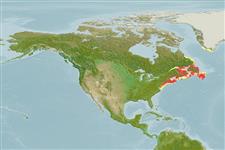Common names from other countries
Environment: milieu / climate zone / depth range / distribution range
Ecología
marino; salobre demersal; rango de profundidad 0 - 73 m (Ref. 57178). Temperate; 62°N - 35°N, 82°W - 3°W (Ref. 57356)
Northwest Atlantic: southern Delaware north to Labrador.
Length at first maturity / Tamaño / Peso / Age
Maturity: Lm 9.0, range 7 - ? cm
Max length : 23.5 cm TL macho / no sexado; (Ref. 5951)
Short description
Claves de identificación | Morfología | Morfometría
Espinas dorsales (total) : 0; Radios blandos dorsales (total) : 52 - 61; Espinas anales: 0; Radios blandos anales: 26 - 33; Vértebra: 62 - 70. Number of lateral plicae 106-126, with a mean of 117.4. Best separated from A. dubius by the number of plicae singly or in combination with the number of vertebrae.
Found in shallow coastal waters as well as in protected bays and estuaries (Ref. 10198). Occurs in large schools and burrows in the sand at times to a depth of several inches. Feeds primarily on copepods (Ref. 27549).
Nizinski, M.S., B.B. Collette and B.B. Washington, 1990. Separation of two species of sand lances, Ammodytes americanus and A. dubius, in the western North Atlantic. Fish. Bull. 88:241-255. (Ref. 10198)
IUCN Red List Status (Ref. 130435)
CITES (Ref. 128078)
Not Evaluated
Threat to humans
Harmless
Human uses
Pesquerías: de interés potencial
Herramientas
Special reports
Download XML
Fuentes de Internet
Estimates based on models
Preferred temperature (Ref.
115969): 2.7 - 14.2, mean 7.9 (based on 128 cells).
Phylogenetic diversity index (Ref.
82804): PD
50 = 0.5156 [Uniqueness, from 0.5 = low to 2.0 = high].
Bayesian length-weight: a=0.00204 (0.00128 - 0.00325), b=3.16 (3.03 - 3.29), in cm Total Length, based on LWR estimates for this species & Genus-body shape (Ref.
93245).
Nivel trófico (Ref.
69278): 3.2 ±0.0 se; based on diet studies.
Resiliencia (Ref.
120179): Medio, población duplicada en un tiempo mínimo de 1.4-4.4 años (Preliminary K or Fecundity.).
Fishing Vulnerability (Ref.
59153): Moderate vulnerability (37 of 100).
